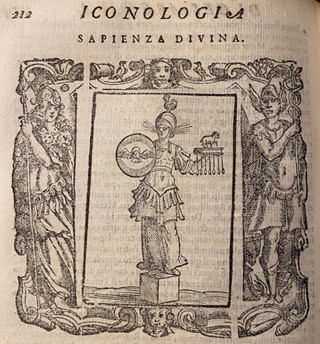- Master of the MET Cabinet, Naples, circa 1615.
Cabinet built with a drop-down front door functioning as a writing desk, containing a chest of drawers composed of ten drawers arranged around a small central compartment hidden behind a door. Veneered in red ebony, with lighter parts of the wood also used to create an unusual and distinctive decorative effect, and inlaid with ivory.
Inside, the chains and pillars are covered with fine ivory decoration, while the drawer fronts are inlaid with scrolling vines inhabited by birds. On the central door is an allegory of Divine Wisdom, derived from Cesare Ripa’s Iconologia, framed by small reserves and dense scrollwork. The inner side of the door is inlaid with simple scroll reserves. The exterior is decorated in the center with ivory inlays depicting an imaginative mythological scene, framed by corner reserves adorned with vine motifs.
In the central scene, a nude female figure rides a sea monster emerging from waters filled with fish with gaping mouths and two half-length male figures: one with a crest, brandishing a large shell, and the other with horns. In a sky filled with a row of small rounded clouds fly a dragon, various birds, and a sort of giant mosquito. To the right, a turreted city rises dramatically above the sea.
The cabinet structure is made of fir wood, with bronze handles, and white bronze corner mounts and internal handles.
Dimensions: 33.5 x 51 x 32 cm
CODE: ANMOAL0166117
Giuseppe Beretti has produced a detailed study of this piece of furniture, of which a twin example is held at the MET. From this coincidence comes the provisional name given to the cabinetmaker who crafted these pieces, of which a third is known and preserved at the V&A Museum, featuring a different iconographic subject.
Barring a few modifications made during the 19th century, the MET cabinet is clearly a twin of the one presented here, sharing identical decorative elements, with the main difference being the themes of the central reserves. In the reserve on the central door of the MET piece, a similar scene is depicted, featuring the same figures, the flying dragon, and the young woman, here placed on solid ground, where another turreted city overlooks the sea. The meaning of these scenes remains unknown; as Giuseppe Beretti notes, they seem to merge mythology with exotic imagery—elements that gained significant popularity and diffusion, particularly during the 17th century.
Inside, on the door, the allegory of Fortitude is represented, once again according to Cesare Ripa’s Iconologia, drawn from the 1613 edition printed in Siena and enriched with approximately two hundred plates. This edition is the first in which Fortitude is shown with a shield resting on the ground rather than held on the arm, which provides a useful clue to the period in which these two cabinets were produced.
Recent archival research by Giuseppe Beretti has brought to light several documents from 1621, including a draft statute for the guild of master cabinetmakers active in Naples. Thirty-seven names are listed, among them eleven foreigners—likely Catholic craftsmen from Flanders and Germany who had migrated after the Protestant Reformation. The name of our cabinetmaker could be hidden among them.
The item is accompanied by a CITES certificate.



FineArt is the new ambitious Di Mano in Mano project that offers an exclusive choice of antiques and design works, presenting them for their singularity and uniqueness.

FineArt by Di Mano in Mano is a team of experts at your service to enhance furniture, paintings, finest antiques, art and design masterpieces at best.
Di Mano in Mano
Via Castellazzo 8, Cambiago (MI)
20040